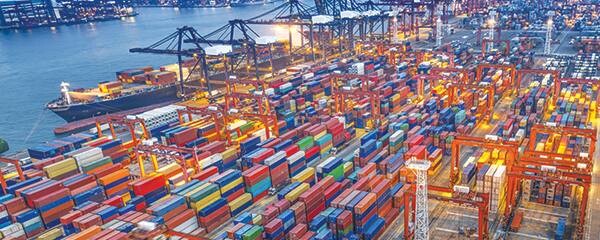09
Sep 2020
COVID-19 IMPACT ON OCEAN FREIGHT PRICES
Plan your container bookings on-time and be aware of sudden cost fluctuations. In August, the peak season for freight started just as the previous years, however, this year Is different due to the pandemic. Although we know that during these months, prices go higher and capacity reduces, the pandemic has been added to the equation that makes more difficult the transportation of goods around the world.
According to the International Maritime Organization, maritime transport is essential to the world’s economy as over 90% of the world’s trade is carried by sea and it is, by far, the most cost-effective way to move en masse goods and raw materials around the world.
1.- Impact of Covid on the Global Logistics Industry
According to Statista, the global freight forwarding market is expected to shrink by 7.5% at worst in 2020 compared with 2019. In a severe impact scenario, the routes in North America, Asia Pacific and in the world are expected to contract by 12.1%, 5.7% and 2.3% respectively in 2020 compared with the previous year. Total container volumes handled at Chinese ports dropped by 10.1% in the first months of 2020.
Agility Logistics mentions that due to reduced volumes, resulting from the fast spreading Coronavirus and a corresponding collapse in demand throughout numerous key markets, the ocean carriers have reacted by pulling out capacity in the form of additional blanks sailing and by eliminating complete strings, reducing total capacity by 50%+ in some large volume trades.
Supply chain disruptions and the lockdowns affects logistics companies. Operational constraints lead to delivery delays, congestion, and higher freight rates.
Matt Leonard, Associate Editor at Supply Chain Dive, says that in June, importers began bringing in more inventory as talks of reopening economies began circulating. This wave of imports hit a freight market with a lot of pulled capacity, and rates skyrocketed. This could be an issue for peak season as well if volume outpaces the container line capacity.
At the end of July, Sea-Intelligence CEO Alan Murphy said in a statement: “…on Asia-North America West Coast, carriers have un-blanked 30 previously announced blank sailings for Q3. From week 29 onwards, virtually no blank sailings are scheduled on the trade lane … with the Y/Y capacity growth suggesting that, from the carriers’ deployment considerations, Coronavirus is no longer as big a challenge.
2.- Ocean Freight Rates for Asia Pacific Exports-Market Outlook for September 2020.[1]
– Europe. Carriers plan a new round of rate increases for September. Additional capacity has been added through extra loaders to balance out supply and demand. Space is extremely tight and rates continue to increase.
– North America. September rate levels are at a record high. Despite the cancelation of blank sailings by carriers and even the introduction of new capacity, ships continue to be full due to the strong demand. Another round of GRI/PSS is expected from mid September as carriers are anticipating the rush before the China Golden Week.
– Latin America. Demand has picked up from the beginning of August and currently outweights the market capacity, with East Coast South America (ECSA) being more severe. Space are already full and rolling for first half of September and the situation is expected to persist for the entire month. On ECSA, carriers are imposing an additional USD 300/Cntr PSS surcharge.
– Middle East and North Africa. Middle East and Gulf continue with the tight space situation. West Africa maintains healthy utilization with no surge in volumes. South and East Africa are showing strong volume increase. Carriers have started to implement rates increases and peak season surcharges from Mid August to September.
3.- Recommendations & Conclusion
Logistics is a diverse sector, recovery prospects will vary depending on the length of lockdowns and the duration of the subsequent economic crisis, however, as an entrepreneur or multinational company you can implement a series of strategies within your organization to avoid extra costs during your international purchasing project:
– Visibility for decision making. Keep a constant communication channel you’re your shipping agents and freight forwarders so they inform your team regarding to any changes in the itineraries, cancellations and availability of spaces, as well as updates in times of transit. Shipping agents and freight forwarders are your strategic ally in the logistics coordination of your operations and therefore constant updates and communication will allow you to plan your times and action plan.
– Flexibility and adaptability. Prioritize the importance of your shipments to be able to weigh the transportation´s rate versus the container´s space. It is common for many companies to have contracts agreed for installments with their logistics agents, however, it has been reported that these contracts are NOT being able to be honored due to the lack of space. As a result of the above, please maintain a flexible stance in the face of current market conditions.
– Optimize your operations for effective and low cost logistics. It is reported that due to the shortage of containers and spaces, shipping lines are asking for deposits for the containers they lease. The Container Loading Supervision inspections not only provide you with a complete picture of the loading conditions of your products in terms of compliance with commercial specifications (product and quantity), but also represents an extra tool that allows you to verify the physical conditions of the containers from origin and detect damages or breakdowns that the containers present from the moment they are positioned for loading.
[1] https://www.dhl.com/content/dam/dhl/global/dhl-global-forwarding/documents/pdf/glo-dgf-ocean-market-update.pdf































